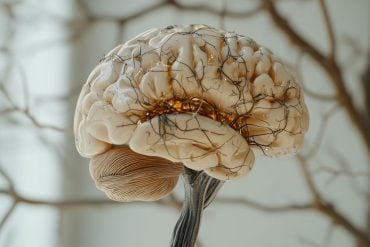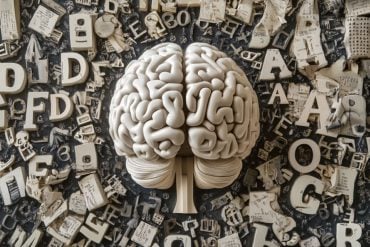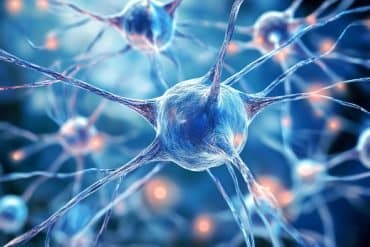Summary: Researchers identify a new mechanism that contributes to learning an association between a warning noise and a fearful event.
Source: Emory Health Sciences.
Researchers identify a new mechanism that contributes to learning an association between an auditory warning and a fearful event.
The music from the movie “Jaws” is a sound that many people have learned to associate with a fear of sharks. Just hearing the music can cause the sensation of this fear to surface, but neuroscientists do not have a full understanding of how that process works.
Now an adult mouse model reveals that changes in lattice-like structures in the brain known as perineuronal nets are necessary to “capture” an auditory fear association and “haul” it in as a longer-term memory. The journal Neuron published the findings by scientists at Emory University and McLean Hospital, a Harvard Medical School affiliate.
The findings could aid research into how to help combat veterans suffering from post-traumatic stress disorder (PTSD).
“We’ve identified a new mechanism — involving the regulation of perineuronal nets in an adult auditory cortex — that contributes to learning an association between an auditory warning and a fearful event,” says Robert Liu, a senior author of the study and an Emory biologist focused on how the brain perceives and processes sound. “It’s surprising,” he adds, “because it was previously thought that these perineuronal nets did not change in an adult brain.”
Another novel finding by the researchers: It’s not just activity in the auditory cortex during a fear-inducing experience associated with sound, but after the experience that is important for the consolidation of the memory.
“What is unexpected is that this brain activity was not in direct response to hearing the actual sound, since animals were just sitting in a quiet room during that period,” Liu says. “This finding could fit with an idea that’s been around for some time, that the way your brain consolidates memories of your day’s experiences is by replaying the events after they have happened.”
The amygdala — a region of the brain located within the temporal lobes — has long been tied to learning what stimuli can trigger emotional reactions such as fear. More recent studies have shown the firing of circuits in the auditory cortex during a threatening sound also play a role in learning what signals should set off a fear reaction.
The auditory part of the brain goes from the ear and cochlea through several stages to reach the auditory cortex — the highest neural processing level for sounds.
Perineuronal nets (PNN) are extracellular lattices that surround and stabilize neurons. During childhood development they have plasticity. “When they eventually mature, they crystalize, locking down the anatomy around the neurons and forming a kind of scaffold,” Liu says. “It’s been thought that these nets remained largely stable in adulthood.”
The mice used in the current research were trained to associate the sound of a tone with a mild shock. The animals eventually would freeze when they heard the sound, in anticipation of the mild shock. Days later, they continued to freeze at the sound even when the shock no longer followed it.
The researchers found that, after the fear-association experience, a transition period lasting about four hours occurs in which the PNN in the rodents’ auditory cortex changed to become stronger. “We speculate that the strengthening of these nets — just like during development — may be putting a brake on further neural plasticity and ‘locking in’ the fear association before other sound experiences interfere with the memory,” Liu says.

When some mice in the study were given an enzyme that dissolved the PNN in the auditory cortex, they stopped remembering to freeze at the sound of the tone. “We essentially removed these nets and that appeared to prevent the fear association from consolidating in the memory, so it fell away faster,” Liu says. “It’s counterintuitive. Before we would have thought if we removed the PNN it would have increased the potential for learning the fear association by increasing the plasticity of the neurons.”
Such research could aid in the development of an intervention for PTSD. “It suggests that there may be a window of time after someone experiences a trauma that you could give them a drug to silence activity in a particular area of the brain,” Liu says. “That might prevent them from consolidating a particular traumatic memory.”
The findings also add to data about how the brain learns in general, and the relationship between receiving new information and a critical time period needed to consolidate it, he says.
First author of the study is Sunayana Banerjee, who conducted the research while she was a post-doctoral fellow at Emory. The lead author is Kerry Ressler – a psychiatrist focused on PTSD who was formerly with the Yerkes National Primate Research Center and Emory University and is now at Mclean Hospital and Harvard Medical School. Co-authors include research specialist Hadj Aoued and Emory undergraduates Vanessa Gutzeit, Justin Baman and Nandini Doshi.
Funding: The research was supported by the National Institutes of Health grants R21MH102191 and R01DC008343 and the Office of Research Infrastructure Programs’ Primate Centers P51OD11132.
Source: Carol Clark – Emory Health Sciences
Image Source: NeuroscienceNews.com image is in the public domain.
Original Research: Abstract for “Perineuronal Nets in the Adult Sensory Cortex Are Necessary for Fear Learning” by Sunayana B. Banerjee, Vanessa A. Gutzeit, Justin Baman, Hadj S. Aoued, Nandini K. Doshi, Robert C. Liu, and Kerry J. Ressler in Science. Published online June 22 2017 doi:10.1016/j.neuron.2017.06.007
[cbtabs][cbtab title=”MLA”]Emory Health Sciences “How Hearing a Warning Sound Turns Into Fearing It Over Time: Mouse Study.” NeuroscienceNews. NeuroscienceNews, 23 June 2017.
<https://neurosciencenews.com/fear-warning-sound-6968/>.[/cbtab][cbtab title=”APA”]Emory Health Sciences (2017, June 23). How Hearing a Warning Sound Turns Into Fearing It Over Time: Mouse Study. NeuroscienceNew. Retrieved June 23, 2017 from https://neurosciencenews.com/fear-warning-sound-6968/[/cbtab][cbtab title=”Chicago”]Emory Health Sciences “How Hearing a Warning Sound Turns Into Fearing It Over Time: Mouse Study.” https://neurosciencenews.com/fear-warning-sound-6968/ (accessed June 23, 2017).[/cbtab][/cbtabs]
Abstract
Perineuronal Nets in the Adult Sensory Cortex Are Necessary for Fear Learning
Highlights
•Auditory cortex activity after auditory fear conditioning is necessary for learning
•Removal of PNNs from the auditory cortex of adult mice decreases fear learning
•Regrowth of PNNs restores the ability to learn new memories
•Temporal regulation of PNNs occurs in response to fear learning
Summary
Lattice-like structures known as perineuronal nets (PNNs) are key components of the extracellular matrix (ECM). Once fully crystallized by adulthood, they are largely stable throughout life. Contrary to previous reports that PNNs inhibit processes involving plasticity, here we report that the dynamic regulation of PNN expression in the adult auditory cortex is vital for fear learning and consolidation in response to pure tones. Specifically, after first confirming the necessity of auditory cortical activity for fear learning and consolidation, we observed that mRNA levels of key proteoglycan components of PNNs were enhanced 4 hr after fear conditioning but were no longer different from the control groups 24 hr later. A similar pattern of regulation was observed in numbers of cells surrounded by PNNs and area occupied by them in the auditory cortex. Finally, the removal of auditory cortex PNNs resulted in a deficit in fear learning and consolidation.
“Perineuronal Nets in the Adult Sensory Cortex Are Necessary for Fear Learning” by Sunayana B. Banerjee, Vanessa A. Gutzeit, Justin Baman, Hadj S. Aoued, Nandini K. Doshi, Robert C. Liu, and Kerry J. Ressler in Science. Published online June 22 2017 doi:10.1016/j.neuron.2017.06.007






